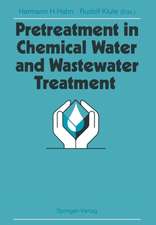Chemical Water and Wastewater Treatment: Proceedings of the 4th Gothenburg Symposium 1990 October 1–3, 1990 Madrid, Spain
Editat de Hermann H. Hahn, Rudolf Kluteen Limba Engleză Paperback – 4 ian 2012
Preț: 1233.83 lei
Preț vechi: 1504.67 lei
-18% Nou
Puncte Express: 1851
Preț estimativ în valută:
236.13€ • 245.61$ • 194.93£
236.13€ • 245.61$ • 194.93£
Carte tipărită la comandă
Livrare economică 14-28 aprilie
Preluare comenzi: 021 569.72.76
Specificații
ISBN-13: 9783642760952
ISBN-10: 3642760953
Pagini: 576
Ilustrații: XI, 560 p.
Dimensiuni: 170 x 242 x 30 mm
Greutate: 0.91 kg
Ediția:Softcover reprint of the original 1st ed. 1990
Editura: Springer Berlin, Heidelberg
Colecția Springer
Locul publicării:Berlin, Heidelberg, Germany
ISBN-10: 3642760953
Pagini: 576
Ilustrații: XI, 560 p.
Dimensiuni: 170 x 242 x 30 mm
Greutate: 0.91 kg
Ediția:Softcover reprint of the original 1st ed. 1990
Editura: Springer Berlin, Heidelberg
Colecția Springer
Locul publicării:Berlin, Heidelberg, Germany
Public țintă
ResearchDescriere
The biennial International Gothenburg Symposia on Chemical Water and Waste water Treatment have proven to be a unique platform for the exchange of ideas and experiences between administrators, engineers and scientists active in the fields of water supply, wastewater disposal and pollution control. The First Symposium (Gothenburg, 1984) provided a long needed survey over theory and application of chemical water and wastewater treatment. The Second Symposium (Berlin, 1986) was devoted to aspects of recycling in chemical water and wastewater technology. The Third Symposium (Gothenburg, 1988) recognised the growing need and the potentials of pretreatment. These proceedings of the 4th Symposium focus on technology transfer from chemical treatment theory to practical treatment of drinking water and industrial or domestic wastewater. The contributions are devoted to questions of floc for mation and floc separation as well as problems and practical solutions associated with chemicals and dosing control. Special attention is given to the combination of chemical and biological processes for nutrient removal from wastewater. It is the editors' privilege to acknowledge the invaluable help from the authors of this book. It is the editors' hope that they might convey the significance and potential of chemical treatment in solving the challenging problems water purification, wastewater disposal and pollution control.
Cuprins
Quo Vadis Chemical Treatment?.- Floc Formation.- Optimization of Flocculation in Connection with Various Solid-Liquid Separation Processes.- Destabilization and Aggregation in Turbulent Pipe Flow.- Colloid Destabilization in the Treatment of Surface Waters Containing Colloid-Stabilizing Pollutants.- Effects of Floc-Virus Association on Chlorine Disinfection Efficiency.- Flocculation in Static Mixer.- Floc Separation.- Pebble Matrix Filtration — A New Way of Floe Separation.- Floc Strength in Bridging Flocculation.- Floc Formation and Breakup in Continuous Flow Flocculation and in Contact Filtration.- Industrial Application of Weighted Flocculation: Development of the Actiflo Clarification Process.- Extended Coagulation for Reagent and Space Savings with Wastewater Lamella Settling.- Liquid-Solid Separation by Elect roflot at ion: An Attractive Alternative to Dissolved Air-Flotation.- Unit Operations for the Removal of Solids and their Combinations in Water Treatment.- Chemicals and Dosing Control.- Coagulation with Prepolymerized Metal Salts.- Simultaneous Phosphate Precipitation and Particle Destabilization Using Aluminium Coagulants of Different Basicity.- The Effect of Five Coagulants on the Concentration and Distribution of Small Particles in Sewage Water.- Process Control of a Chemical Water Treatment Plant by a Continuous Flocculation Test.- Increasing the Surface Load at a Direct-Precipitation Plant, VEAS, Norway.- Drinking Water.- Control of Reservoir Water Quality.- Optimization of Sequential Unit Operations for Removal of Organics from Drinking Water.- Methods of Improving Granular Filters for Water Purification.- Aluminum Coagulation of Natural Organic Matter.- Treatment of Coloured Surface Water by Coagulation/Direct Filtration: Effect of Water Quality, Type of Coagulant and Filter Aids.- A Simple Test for Determination of Optimal Doses in the Treatment of Humic Waters.- Two-Stage Iron(III) Coagulation As a Method of Improving the Effectiveness of the Water Purification Process.- Residual Aluminium Concentration in Drinking Water After Treatment with Aluminium or Iron Salts.- Wastewater Treatment.- Pre-Precipitation and the High-Rate Process for Domestic Wastewater Pretreatment in Finland — A Case Study.- Measures for Nutrient Removal from Sewage Wastewaters in Estonia.- Full Scale Experience with Biological and Chemical Phosphorus Removal.- Upgrading a Primary Treatment Plant for Nutrient Removal.- Ammonia and Phosphate Elimination by Biologically Intensified Flocculation Filtration Process.- Virus Risk Analysis in Wastewater Reclamation and Reuse.- Sludge as Carbon Source for Denitrification.- Chemical-Biological Nutrient Removal — The HYPRO Concept.- Biological Hydrolysis of Sludge from Primary Precipitation.- Carbon Source for Denitrification from Pre-Precipitated Sludge.- The Use of Industrial By-Products as a Carbon Source for Denitrification.- Improving the Denitrification Potential in Biological Wastewater Treatment by Dosing Carbon from Sludge Hydrolysis.



















